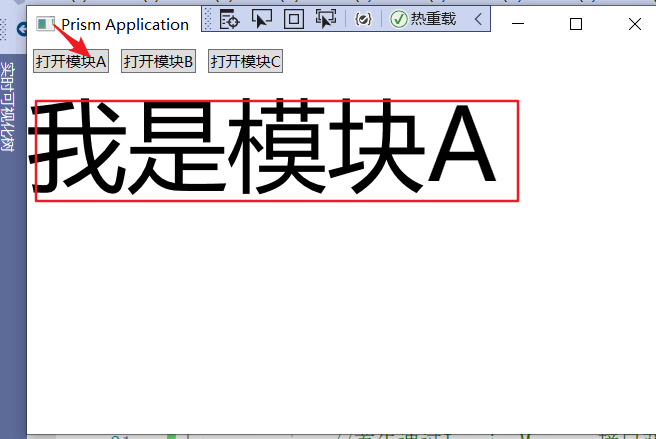功能
通过点击不同的Button,实现显示不同的界面

View部分
MainWindow.xaml
- 两个
<Grid.RowDefinitions/>,上面放Button,下面放导航页面。导航页面用<ContentControl/>介绍ContentControl1
<Window
x:Class="FullApp.Views.MainWindow"
xmlns="http://schemas.microsoft.com/winfx/2006/xaml/presentation"
xmlns:x="http://schemas.microsoft.com/winfx/2006/xaml"
xmlns:prism="http://prismlibrary.com/"
Title="{Binding Title}"
Width="525"
Height="350"
prism:ViewModelLocator.AutoWireViewModel="True">
<Grid>
<Grid.RowDefinitions>
<RowDefinition Height="auto" />
<RowDefinition/>
</Grid.RowDefinitions>
<StackPanel Orientation="Horizontal">
<Button
Margin="5"
Command="{Binding OpenCommand}"
CommandParameter="ViewA"
Content="打开模块A" />
<Button
Margin="5"
Command="{Binding OpenCommand}"
CommandParameter="ViewB"
Content="打开模块B" />
<Button
Margin="5"
Command="{Binding OpenCommand}"
CommandParameter="ViewC"
Content="打开模块C" />
</StackPanel>
<ContentControl Grid.Row="1" prism:RegionManager.RegionName="ContentRegion"/>
</Grid>
</Window>
创界导航页面
ViewB、ViewC和ViewA类似。

<UserControl x:Class="FullApp.Views.ViewA"
xmlns="http://schemas.microsoft.com/winfx/2006/xaml/presentation"
xmlns:x="http://schemas.microsoft.com/winfx/2006/xaml"
xmlns:mc="http://schemas.openxmlformats.org/markup-compatibility/2006"
xmlns:d="http://schemas.microsoft.com/expression/blend/2008"
xmlns:local="clr-namespace:FullApp.Views"
mc:Ignorable="d"
d:DesignHeight="450" d:DesignWidth="800">
<Grid>
<TextBlock Text="我是模块A"
FontSize="80" />
</Grid>
</UserControl>
using System;
using System.Collections.Generic;
using System.Text;
using System.Windows;
using System.Windows.Controls;
using System.Windows.Data;
using System.Windows.Documents;
using System.Windows.Input;
using System.Windows.Media;
using System.Windows.Media.Imaging;
using System.Windows.Navigation;
using System.Windows.Shapes;
namespace FullApp.Views
{
/// <summary>
/// ViewA.xaml 的交互逻辑
/// </summary>
public partial class ViewA : UserControl
{
public ViewA()
{
InitializeComponent();
}
}
}
ViewModels
- 创建命令
public DelegateCommand<string> OpenCommand { get; private set; }
- MainWindowViewModel的构造函数要用到第一步创建的命令,传进一个函数
Open
private readonly IRegionManager regionManager;
public MainWindowViewModel(IRegionManager regionManger)
{
OpenCommand = new DelegateCommand<string>(Open);
this.regionManager = regionManger;
}
这个地方参数为regionManger,是View部分xmal prism:RegionManager.RegionName="ContentRegion"末尾部分的区域
-
Open依赖注入(DI)2
private void Open(string obj)
{
//首先通过IregionManager接口获取全局定义的区域
//往这个区域动态的去设置内容
//设置内容的方式是依赖注入
regionManager.Regions["ContentRegion"].RequestNavigate(obj);
}
这里用了依赖注入,如果不用依赖注入Open里面将会实例多个导航界面,导航界面和本类形成依赖
- 依赖注入注册,在
APP.xaml里实现
using FullApp.Views;
using Prism.DryIoc;
using Prism.Ioc;
using System.Windows;
namespace FullApp
{
/// <summary>
/// Interaction logic for App.xaml
/// </summary>
public partial class App:PrismApplication
{
protected override Window CreateShell()
{
return Container.Resolve<MainWindow>();
}
protected override void RegisterTypes(IContainerRegistry containerRegistry)
{
containerRegistry.RegisterForNavigation<ViewA>("ViewA");
containerRegistry.RegisterForNavigation<ViewB>("ViewB");
containerRegistry.RegisterForNavigation<ViewC>("ViewB");
}
}
}
介绍ContentControl
ContentControl控件是一种可以添加和自定义的控件,用于在模板、表单和文档中包含特定类型的内容[1](https://support.microsoft.com/en-us/office/about-content-controls-283b1e29-0b77-4781-b236-2d02c1cce1c2)[2](https://learn.microsoft.com/en-us/office/vba/word/Concepts/Working-with-Word/working-with-content-controls)。例如,你可以使用ContentControl控件来创建一个下拉列表,让用户从有限的选项中选择[1](https://support.microsoft.com/en-us/office/about-content-controls-283b1e29-0b77-4781-b236-2d02c1cce1c2)。
ContentControl控件可以包含任意类型的内容,如日期、列表或格式化文本[2](https://learn.microsoft.com/en-us/office/vba/word/Concepts/Working-with-Word/working-with-content-controls)。你可以通过设置ContentControl控件的属性来控制其外观和行为,如标题、标签、颜色、锁定等[1](https://support.microsoft.com/en-us/office/about-content-controls-283b1e29-0b77-4781-b236-2d02c1cce1c2)[2](https://learn.microsoft.com/en-us/office/vba/word/Concepts/Working-with-Word/working-with-content-controls)。
在WPF中,ContentControl控件是一个基类,有很多派生类,如Button、Label、CheckBox等[3](https://blog.csdn.net/BYH371256/article/details/125513486)[4](https://zhuanlan.zhihu.com/p/358449148)。你可以使用XAML或代码来创建和操作ContentControl控件[3](https://blog.csdn.net/BYH371256/article/details/125513486)[4](https://zhuanlan.zhihu.com/p/358449148)[5](https://zhuanlan.zhihu.com/p/514311839)。
在Word中,ContentControl对象是一个代表文档中内容控件的对象,你可以使用VBA来插入、删除、修改或查询内容控件的属性和方法[6](https://learn.microsoft.com/zh-cn/office/vba/api/word.contentcontrol)。
↩︎
依赖注入(DI)
定义:
依赖注入(DI)是一种软件设计模式,它可以实现控制反转(IoC),即让类的依赖项由外部提供,而不是在类内部创建[1](https://www.malema.net/csharp-di/intro.html)[2](https://learn.microsoft.com/zh-cn/dotnet/core/extensions/dependency-injection)。这样可以降低类之间的耦合,提高代码的可测试性和可维护性[1](https://www.malema.net/csharp-di/intro.html)[2](https://learn.microsoft.com/zh-cn/dotnet/core/extensions/dependency-injection)。
C#中有很多支持依赖注入的框架,如Autofac、Ninject、Unity等[3](https://www.zhihu.com/question/27181326)。你也可以使用.NET自带的依赖注入机制,通过IServiceCollection接口来注册服务,并通过IServiceProvider接口来获取服务[2](https://learn.microsoft.com/zh-cn/dotnet/core/extensions/dependency-injection)[4](https://learn.microsoft.com/zh-cn/aspnet/core/fundamentals/dependency-injection?view=aspnetcore-6.0)[5](https://learn.microsoft.com/zh-cn/dotnet/core/extensions/dependency-injection-usage)。
在ASP.NET Core中,依赖注入是一个内置的功能,你可以在Startup类中配置服务,并在控制器、过滤器、视图等地方使用构造函数注入或属性注入的方式来获取服务[6](https://blog.csdn.net/qq_39173779/article/details/129476121)[4](https://learn.microsoft.com/zh-cn/aspnet/core/fundamentals/dependency-injection?view=aspnetcore-6.0)。
如果你想了解更多关于C#中依赖注入的内容,请参考以下链接:
- 《C# 依赖注入介绍》[1](https://www.malema.net/csharp-di/intro.html)
- 《.NET 中的依赖关系注入》[2](https://learn.microsoft.com/zh-cn/dotnet/core/extensions/dependency-injection)
- 《ASP.NET Core 依赖注入》[4](https://learn.microsoft.com/zh-cn/aspnet/core/fundamentals/dependency-injection?view=aspnetcore-6.0)
- 《使用依赖关系注入》[5](https://learn.microsoft.com/zh-cn/dotnet/core/extensions/dependency-injection-usage)
DI:Dependention Injection
还有个
DI叫依赖反转Dependention Inversion pre...一般用反射不会这么用,都是用封装好的反射,又叫依赖注入。
依赖注入框架:Nuget–DependencyInjection
添加名称空间:using Microsolft.Extensions.DependencyInjection
typeof

依赖注入有个很重要的容器ServiceProvider
var sc new ServiceCollection();这就是个容器。
sc.AddScoped(typeof(ITank),typeof(MediumTank));把一对类型放进了容器
分割线以上是一次性注册,分割线以下代表在程序其他任何地方都可以用。 ↩︎






















 389
389











 被折叠的 条评论
为什么被折叠?
被折叠的 条评论
为什么被折叠?








